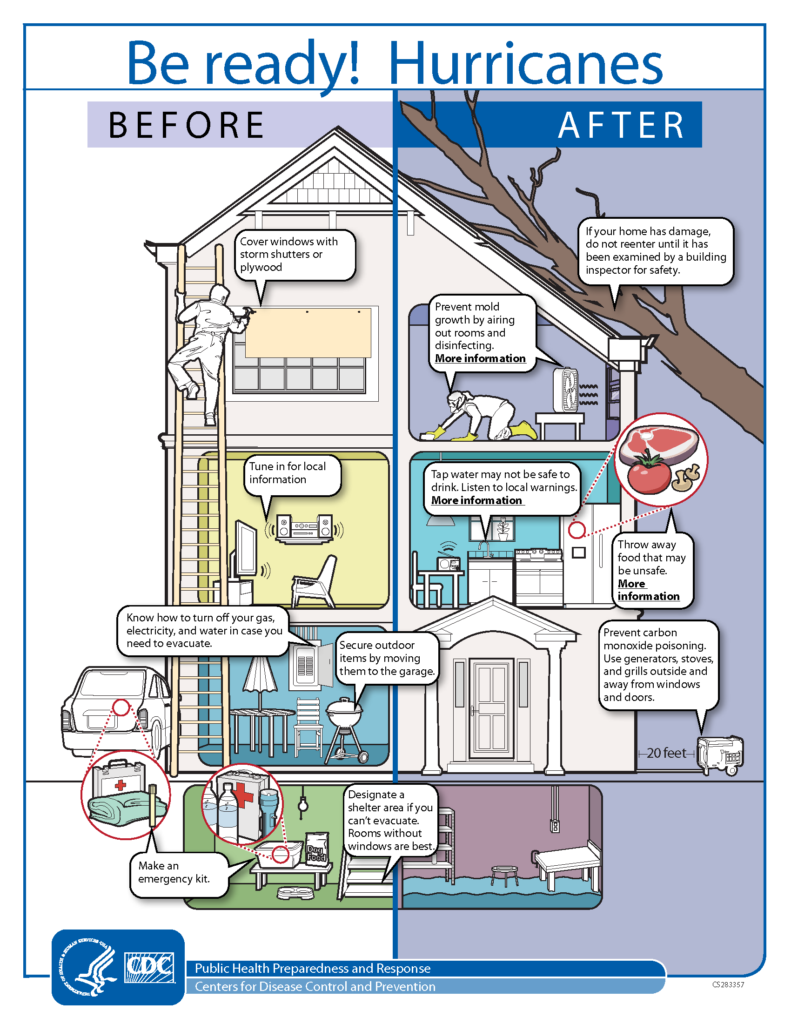It’s peak hurricane season. Time to prepare your home for a hurricane
- Peak hurricane season is mid-August through late October.
- Start now to be prepared for a hurricane: create your emergency plan and communication plan. Here’s what it should entail.
- Pack an emergency kit. Include these items.
- Take these steps to secure your property as much as possible.
Did you know peak hurricane season starts now? It’s mid-August through late October. If you haven’t already done so, it’s time to prepare your home for a hurricane. Of course, your first priority is ensuring the safety of your family and others living in your home, whether you’re a homeowner or renter.
Here are suggested steps you’ll need to take beginning now, if you live in a hurricane-prone area along the Eastern Seaboard or Gulf Coast.
1. Create an emergency plan
Your hurricane emergency plan should include an evacuation plan that takes into account various scenarios, along with a communications plan.
You can create your evacuation plan when you know the designated evacuation routes in your area, and the quickest way to get to higher ground. Decide now at what point you’ll evacuate and where you will go. You’ll also want to know whether your area is flood-prone, so that you can take steps to protect your property against storm surge or flooding. Check FEMA’s website to find out. Just enter your address and the website will tell you.
Consider various scenarios that may occur: How will your evacuation plan change if you’re at work and the kids are at school or daycare? What if you have an elderly or disabled person in your home? What about your pets?
Next, determine how you’ll communicate with other family and friends to alert them of your new location and that you’re safe. Cell phone towers may be down. Consider using Facebook Messenger or even the Next Door app…or finding a good, old-fashioned payphone to connect.
2. Stock your emergency kit
You’ll also want to stock your disaster supplies kit now. According to Ready.Gov, here’s how to stock your kit:
- Water (one gallon per person per day for several days, for drinking and sanitation)
- Food (at least a three-day supply of non-perishable food)
- Battery-powered or hand-crank radio and a NOAA Weather Radio with tone alert
- Flashlight
- First aid kit
- Extra batteries
- Whistle (to signal for help)
- Dust mask (to help filter contaminated air)
- Plastic sheeting and duct tape (to shelter in place)
- Moist towelettes, garbage bags and plastic ties (for personal sanitation)
- Wrench or pliers (to turn off utilities)
- Manual can opener (for food)
- Local maps
- Cell phone with chargers and a backup battery
You may also want to add these items that pertain to your specific needs:
- Masks (for everyone ages 2 and above), soap, hand sanitizer, disinfecting wipes to disinfect surfaces
- Prescription medications
- Non-prescription medications such as pain relievers, anti-diarrhea medication, antacids or laxatives
- Prescription eyeglasses and contact lens solution
- Infant formula, bottles, diapers, wipes and diaper rash cream
- Pet food and extra water for your pet
- Cash or traveler’s checks
- Important family documents such as copies of insurance policies, identification and bank account records saved electronically or in a waterproof, portable container
- Sleeping bag or warm blanket for each person
- Complete change of clothing appropriate for your climate and sturdy shoes
- Fire extinguisher
- Matches in a waterproof container
- Feminine supplies and personal hygiene items
- Mess kits, paper cups, plates, paper towels and plastic utensils
- Paper and pencil
- Books, games, puzzles or other activities for children
- Fully fueled vehicles, with extra fuel stored in safe containers.
3. How to prepare your home for a hurricane
Start prepping your home as soon as a hurricane watch is sounded. If you must evacuate, you may not have the time to prepare your home. Start by securing any outdoor objects that could become flying missiles: toys, bikes, outdoor furniture, garbage cans, etc.
Other ways to prepare your home for a hurricane include cutting back any tree limbs close to your house or other structures. Clean out your gutters and drains so that water can flow unimpeded.
Have enough plywood (5/8 inch marine plywood is recommended) on hand, already cut to size, to cover your windows, if you don’t have hurricane shutters. Experts say just taping your windows is a waste of your precious time. Consider installing straps or additional clips to securely fasten your roof to the frame structure, to reduce roof damage.
Related: Storm season preparation tips for your property owners
Consider these additional steps:
- Reinforce your garage doors. If wind enters a garage, it can cause dangerous and expensive structural damage.
- Remove window air conditioners.
- If basements are present, check sump pumps and battery back-up.
- Determine how and where to secure your boat (if applicable). Learn more here.
- Install a generator for emergencies.
- If in a high-rise building, be prepared to take shelter on or below the 10th If in a home, determine the best location for a safe room.
View this infographic below for a quick look at house preparations before a hurricane strikes from the CDC.

Don’t wait until a hurricane warning has been issued to prepare your home for a hurricane. Taking these initial preparation steps now will save you precious time when a hurricane is eminent.
When the hurricane is past, view these safety tips on returning home.
Agents, take a look at our Homeowners Program to add to your portfolio of insurance solutions.

![You are currently viewing How to prepare your home for a hurricane [infographic]](https://www.arrowheadgrp.com/wp-content/uploads/2021/08/AH-8.17-first-aid-BLOG.png)